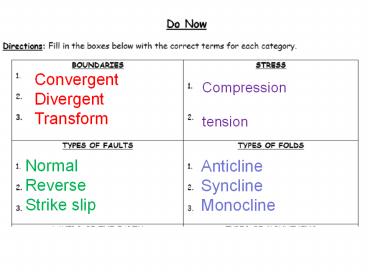Chapter 4: Section 1 Notes Inside the Earth - PowerPoint PPT Presentation
1 / 14
Title:
Chapter 4: Section 1 Notes Inside the Earth
Description:
Title: Chapter 4: Section 1 Notes Inside the Earth Author: smuller Last modified by: Zuhl, Jean Marie Created Date: 3/16/2006 5:46:57 PM Document presentation format – PowerPoint PPT presentation
Number of Views:124
Avg rating:3.0/5.0
Title: Chapter 4: Section 1 Notes Inside the Earth
1
Convergent Divergent Transform
Compression tension
Normal Reverse Strike slip
Anticline Syncline Monocline
2
Folded Fault-block Volcanic
Lithosphere Asthenosphere Mesosphere Outer
core Inner core
Puzzle Fossils Rock types Glaciers Sea floor
spreading
3
Uniformitarianism
- The geologic processes that we observe today have
been at work throughout Earths history - Example Erosion, deposition, and slow climate
changes remain the same over time.
James Hutton
Charles Lyell
4
Catastrophism
- States that all geologic change occurs suddenly.
- Example Mountains, canyons, asteroids,
earthquakes, volcanoes
5
- Layers of the Earth
- Composition
- Crust
- Mantle
- Core
- Physical properties
- ) Lithosphere
- ) Asthenosphere
- ) Mesosphere
- ) Outer core
- ) Inner core
6
Tectonic Plates
- Pieces of the lithosphere that move around on the
asthenosphere. - Made of continental crust, oceanic crust or both
7
Depths of the Earth
- Scientists cannot visit the depths of the Earth
like the mantle and the core but use seismic
waves recorded by seismographs during earthquake
activity.
8
Alfred Wegener 1911
Theory called Plate Tectonics or Continental
Drift Earths lithosphere is divided into
tectonic plates that move around on top of the
asthenosphere. The continents once formed a
single landmass, broke up, and drifted to their
present locations.
9
Proof of Wegeners Theory
- The continents seem to fit together.
- Fossils of the same plant and animal species are
found on continents that are on different sides
of the Atlantic Ocean. - Similar types of rock were found on several
continents. - Evidence of the same ancient climatic conditions
were found on several continents. - Sea Floor Spreading
10
- Boundary - where tectonic plates meet
- Convergent
- Divergent
- transform
- Fault place where rocks break and move
- Normal
- Reverse
- transform
- Stress pressure on rock
- Compression
- tension
11
Boundaries crust examples Type of stress Type of fault HW/FW up or down
o-o
c-o
c-c
o-o
c-c
c-c
12
Boundaries crust examples stress fault HW/FW up or down
convergent o-o subduction zone, Marianas Trench compression reverse HW up, FW down
convergent c-o subduction zone, Japan, Washington compression reverse HW up, FW down
convergent c-c Himalayas compression reverse HW up, FW down
divergent o-o mid ocean ridge tension normal HW down, FW up
divergent c-c Iceland, East Africa Rift Valley tension normal HW down, FW up
transform c-c San Andreas shearing strike slip side to side
13
3 types of folds
syncline
monocline
anticline
14
3 Types of Mountains
Folded
volcanic
Fault block

